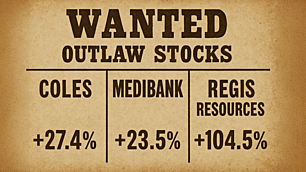The Fallen: Stocks hitting 52-week lows (and what investors should do)
Earlier this week, I covered The Outlaws – stocks hitting 52-week highs despite the market sinking.
.png)
Unlike in 2022, when almost every asset class fell in lockstep, this year we’ve seen defensives and fixed income ETFs do what they’re meant to do: offer ballast in a storm.
Now, let's flip the script and look at the stocks and ETFs which hit 52-week lows before today's bigger-than-Ben-Hur rally. We'll call them: The Fallen.
To be sure, these aren’t necessarily all bad businesses. As fund managers like Emanuel Datt, Adam Dawes, and Nick Peros have pointed out, a stock hitting a 52-week low isn’t always a red flag. It's a potential opportunity to pick up quality at a discount.
In this piece, we look at some of the market’s most beaten-down names and ask the experts for their opinion on whether they’re falling knives – or genuine bargains.
Due to the sheer number of names hitting 52-week low, we’ve (mostly) focused this wire on two key ASX sectors – resources and financials – with expert insights to help investors make sense of the wreckage. You can download the full list below or use the scans on Market Index.
Resources: Down... and out?
Stocks tied to bulk materials like lithium, nickel, alumina, uranium, and service providers to the sector, have been hammered. Investor sentiment toward global growth, Chinese demand, and commodity consumption has soured, and the miners have paid the price.
| Code | Company | Price | 1-Year | Market Cap |
|---|---|---|---|---|
| MIN | Mineral Resources | $14.4 | -80.01% | $3.2B |
| PLS | Pilbara Minerals | $1.305 | -66.71% | $4.4B |
| FMG | Fortescue | $14.32 | -39.75% | $45.6B |
| BHP | BHP Billiton | $15.23 | -20.2% | $179.6B |
| ORI | Orica Ltd | $15.31 | -12.59% | $7.62B |
Performance data based on 52-week lows recorded between 7–9 April 2025 (Source: Market Index).
“The impact of tariffs on commodity demand is uncertain, but we expect some inventory destocking and a reduction in metal consumption over the next six months,” says Paul Young, Mining Analyst at Goldman Sachs.
But not all miners are faring equally. BHP (ASX: BHP) and Rio Tinto (ASX: RIO) have held up better, thanks to their stronger balance sheets and diversified revenues.
Young views the recent dip in BHP and Rio shares as a potential buying opportunity but he’s more bullish on the latter. Backed by a stronger production outlook, Goldman believes Rio Tinto, under CEO Jakob Stausholm, could surpass BHP in EBITDA by 2030. They’re forecasting free cash flow yields of 7–8% for Rio, compared to just 4% for BHP.
But it’s Mineral Resources (ASX: MIN) that stands out — and not in a good way. The stock has been beaten to a pulp this year, hit by both sector-wide sentiment and company-specific concerns. TenCap's Jun Bei Liu was early to call a Sell rating back in February on Buy Hold Sell.
“With the amount of debt this company’s holding, there’s just way too much risk,” Liu said, a sentiment echoed by Goldman, which expects MIN’s debt to peak at $5.6 billion this year.
But Rahul Anand, Head of Australia Materials Research at Morgan Stanley, believes value is emerging. He gives it an overweight waiting and reckons the stock could double.
“We like MIN’s commodity mix amid an improving backdrop for iron ore. As the Ashburton project ramps up, we see leverage improving from FY25," he says.
Financials: Active managers fall from grace; banks dive
It’s been a brutal year for listed fund managers. A combination of slowing inflows, fee compression, and cautious investors has hit revenues and sent valuations tumbling, in some cases, well below broader market declines.
| Code | Company | Price | 1-Year | Market Cap |
|---|---|---|---|---|
| RPL / PTM MFG / PPT GQG |
Regal / Platinum Magellan / Perpetual GQG Partners |
-- | -19.45% to -34.83% | -- |
| MQG | Macquarie Group | $172.54 | -6.89% | $68.2B |
| ANZ | ANZ Group | $26.83 | -3.54% | $80.4B |
| NAB | National Australia Bank | $32.19 | -2.67% | $99.5B |
| NGI* | Navigator Global | $1.61 | 0.83% | $0.79B |
Based on 9 April 2025 closing prices (Source: Market Index), *NGI hit a 52-week low before closing higher for the day
Morgan Stanley picks GQG
Amid the sector selloff, Morgan Stanley sees value in GQG Partners (ASX: GQG), which runs global and emerging markets funds.
“Despite market pressure, GQG trades at just 7x FY26E P/E, with strong flows and a solid track record,” said analysts Richard Wiles, Andrei Stadnik, and Sally Hong. They’ve set a $3.16 price target, implying ~70% upside.
Magellan (ASX: MFG), by contrast, remains challenged by outflows, falling base fees, and strategic uncertainty. But it could become a turnaround story.
"It has a strong balance sheet to deploy for growth. Over time, its new strategy and focus on strategic partnerships should deliver stronger flows as MFG becomes a multi-boutique business," the analysts said.
Henry Jennings buys Pinnacle; eyes Macquarie
Henry Jennings of Marcus Today prefers diversified asset manager Pinnacle Investment Management (ASX: PNI), which holds stakes in a suite of fund managers across different asset classes.
“Asset managers are geared to equity market falls, sure — but I’ve picked up shares of Pinnacle Investment Management (ASX: PNI),” says Jennings.
Notably, the Marcus Today strategy portfolio moved to 100% cash on March 3, as flagged by Marcus Padley. But Jennings says the team isn’t sitting idle, they’re actively building a watchlist and preparing to deploy capital when the right opportunities arise.
P.S. Don’t miss what the Marcus Today team is saying about ‘timing the bottom’ — more on that below.

Jennings is also watching Macquarie Group (ASX: MQG), which hit a 52-week low this week but is still a tad expensive for his liking.
“Macquarie thrives on volumes and volatility. The issue is the deal flow drying up. It would’ve been great buying at the $160-handle with hindsight. If it tests that again, I’d be interested.”
He also recently added the Betashares NASDAQ 100 ETF (ASX: NDQ) as a more diversified way to gain exposure without having to pick individual technology winners - a sign the Marcus team sees value returning to the market, with a view that tech will once again lead the charge.
“We dipped a toe into US tech via NDQ — it’s just a toe, but ETFs offer easier asset allocation than trying to pick which stock at 52-week lows will rebound.”
Pick your poison wisely
Beyond sector-specific stories, some experts are taking a step back and thinking bigger picture.
Rudi Filapek-Vandyck of FNArena urges investors to focus on quality and resilience, especially with recession and inflation risks still looming.
“The irony is that a stock trading on 30x next year’s profit can be a better investment than one on a single-digit PE — but not under all circumstances,” he says.
Rudi notes that in a deep recession or inflation spike, even quality growth stocks will struggle. But assuming those scenarios don’t play out, he sees the best risk-reward in high-multiple growth stocks with durable earnings — like TechnologyOne (TNE), REA Group (REA), Xero (XRO) and ResMed (RMD).
“While they’re not immune to setbacks or tariffs, these companies are far less likely to issue a severe profit warning than small caps like Nuix (NXL),” he says.
His biggest caution? Small caps with low liquidity and high leverage.
“A stock that’s fallen 90%? That’s a stock that first fell 80%, and then halved again.”
WHAT ABOUT CSL?
CSL (ASX: CSL), one of his long-time favourites and the #1 most-tipped stock by Livewire readers this year, also made 52-week lows this year; down ~13% in the past months.
Filapek-Vandyck says the company's operational momentum is improving, but warns anti-vaccine sentiment in the US is weighing on sentiment.
"The reason for owning CSL shares is still because of continued growth in plasma and related products, plus margin expansion as promised by management," he says.
Final thoughts
Markets always have winners and losers, but a stock hitting a 52-week low doesn’t automatically make it broken. Sometimes it’s a bargain, sometimes it’s a trap.
In this tricky, macro-driven market, investors need to be highly selective, leaning on balance sheet strength, earnings resilience, and structural growth stories. Because in markets like this, cheap can get even cheaper. But quality tends to bounce back.
2 topics
9 stocks mentioned
1 fund mentioned
2 contributors mentioned

